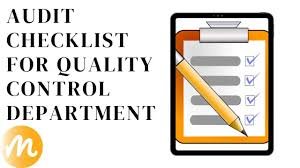Checklist for Audit in Quality Control

QC Audit Checklist
1. General Documentation & Records
-
SOPs for all QC activities (latest approved versions, controlled copies).
-
Records of training, competency assessments, and analyst qualification.
-
QC logbooks (instrument usage, calibration, maintenance).
-
Change control records affecting QC methods or equipment.
-
Data integrity compliance (audit trails, raw data storage, secure backups).
2. Sample Management
-
Proper receipt, labeling, and storage of samples.
-
Chain of custody documentation.
-
Retention sample management and disposal procedures.
-
Segregation of rejected and approved samples.
3. Testing & Methodology
-
Approved test methods (validated/verified).
-
System suitability and method performance checks.
-
Handling of OOS, OOT, and deviations.
-
Correct and consistent use of reference standards.
-
Calibration of glassware and volumetric devices.
4. Instruments & Equipment
-
Calibration schedules and certificates.
-
Preventive maintenance records.
-
Qualification documents (IQ, OQ, PQ).
-
Cleaning and shutdown/startup procedures.
-
Equipment logbooks updated and signed.
5. Reagents, Solvents & Mobile Phases
-
Storage conditions (temperature, light protection).
-
Expiry and requalification status.
-
Labeling with preparation date, expiry, initials.
-
Use of analytical-grade or specified quality solvents.
6. Laboratory Practices
-
Compliance with safety procedures and PPE usage.
-
Glassware cleaning SOPs followed.
-
No cross-contamination between testing areas.
-
Controlled environmental conditions (temperature, humidity).
-
Waste disposal records and safety compliance.
7. Data Integrity & Reporting
-
Original raw data preserved and accessible.
-
No unauthorized changes in results.
-
Electronic records with secure login and restricted access.
-
Audit trails reviewed regularly.
-
Proper review and approval by authorized personnel.
8. Stability Studies (if applicable)
-
Approved stability protocols.
-
Proper storage of stability chambers.
-
Monitoring of environmental conditions.
-
Stability data trending and review.

